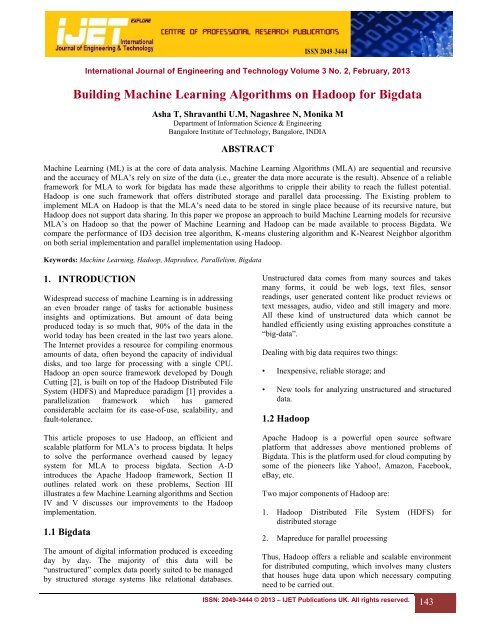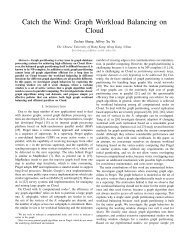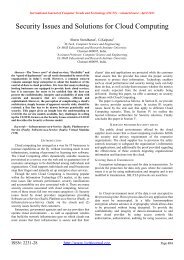Building Machine Learning Algorithms on Hadoop for Bigdata
Building Machine Learning Algorithms on Hadoop for Bigdata
Building Machine Learning Algorithms on Hadoop for Bigdata
Create successful ePaper yourself
Turn your PDF publications into a flip-book with our unique Google optimized e-Paper software.
Internati<strong>on</strong>al Journal of Engineering and Technology Volume 3 No. 2, February, 2013<br />
<str<strong>on</strong>g>Building</str<strong>on</strong>g> <str<strong>on</strong>g>Machine</str<strong>on</strong>g> <str<strong>on</strong>g>Learning</str<strong>on</strong>g> <str<strong>on</strong>g>Algorithms</str<strong>on</strong>g> <strong>on</strong> <strong>Hadoop</strong> <strong>for</strong> <strong>Bigdata</strong><br />
Asha T, Shravanthi U.M, Nagashree N, M<strong>on</strong>ika M<br />
Department of In<strong>for</strong>mati<strong>on</strong> Science & Engineering<br />
Bangalore Institute of Technology, Bangalore, INDIA<br />
ABSTRACT<br />
<str<strong>on</strong>g>Machine</str<strong>on</strong>g> <str<strong>on</strong>g>Learning</str<strong>on</strong>g> (ML) is at the core of data analysis. <str<strong>on</strong>g>Machine</str<strong>on</strong>g> <str<strong>on</strong>g>Learning</str<strong>on</strong>g> <str<strong>on</strong>g>Algorithms</str<strong>on</strong>g> (MLA) are sequential and recursive<br />
and the accuracy of MLA’s rely <strong>on</strong> size of the data (i.e., greater the data more accurate is the result). Absence of a reliable<br />
framework <strong>for</strong> MLA to work <strong>for</strong> bigdata has made these algorithms to cripple their ability to reach the fullest potential.<br />
<strong>Hadoop</strong> is <strong>on</strong>e such framework that offers distributed storage and parallel data processing. The Existing problem to<br />
implement MLA <strong>on</strong> <strong>Hadoop</strong> is that the MLA’s need data to be stored in single place because of its recursive nature, but<br />
<strong>Hadoop</strong> does not support data sharing. In this paper we propose an approach to build <str<strong>on</strong>g>Machine</str<strong>on</strong>g> <str<strong>on</strong>g>Learning</str<strong>on</strong>g> models <strong>for</strong> recursive<br />
MLA’s <strong>on</strong> <strong>Hadoop</strong> so that the power of <str<strong>on</strong>g>Machine</str<strong>on</strong>g> <str<strong>on</strong>g>Learning</str<strong>on</strong>g> and <strong>Hadoop</strong> can be made available to process <strong>Bigdata</strong>. We<br />
compare the per<strong>for</strong>mance of ID3 decisi<strong>on</strong> tree algorithm, K-means clustering algorithm and K-Nearest Neighbor algorithm<br />
<strong>on</strong> both serial implementati<strong>on</strong> and parallel implementati<strong>on</strong> using <strong>Hadoop</strong>.<br />
Keywords: <str<strong>on</strong>g>Machine</str<strong>on</strong>g> <str<strong>on</strong>g>Learning</str<strong>on</strong>g>, <strong>Hadoop</strong>, Mapreduce, Parallelism, <strong>Bigdata</strong><br />
1. INTRODUCTION<br />
Widespread success of machine <str<strong>on</strong>g>Learning</str<strong>on</strong>g> is in addressing<br />
an even broader range of tasks <strong>for</strong> acti<strong>on</strong>able business<br />
insights and optimizati<strong>on</strong>s. But amount of data being<br />
produced today is so much that, 90% of the data in the<br />
world today has been created in the last two years al<strong>on</strong>e.<br />
The Internet provides a resource <strong>for</strong> compiling enormous<br />
amounts of data, often bey<strong>on</strong>d the capacity of individual<br />
disks, and too large <strong>for</strong> processing with a single CPU.<br />
<strong>Hadoop</strong> an open source framework developed by Dough<br />
Cutting [2], is built <strong>on</strong> top of the <strong>Hadoop</strong> Distributed File<br />
System (HDFS) and Mapreduce paradigm [1] provides a<br />
parallelizati<strong>on</strong> framework which has garnered<br />
c<strong>on</strong>siderable acclaim <strong>for</strong> its ease-of-use, scalability, and<br />
fault-tolerance.<br />
This article proposes to use <strong>Hadoop</strong>, an efficient and<br />
scalable plat<strong>for</strong>m <strong>for</strong> MLA’s to process bigdata. It helps<br />
to solve the per<strong>for</strong>mance overhead caused by legacy<br />
system <strong>for</strong> MLA to process bigdata. Secti<strong>on</strong> A-D<br />
introduces the Apache <strong>Hadoop</strong> framework, Secti<strong>on</strong> II<br />
outlines related work <strong>on</strong> these problems, Secti<strong>on</strong> III<br />
illustrates a few <str<strong>on</strong>g>Machine</str<strong>on</strong>g> <str<strong>on</strong>g>Learning</str<strong>on</strong>g> algorithms and Secti<strong>on</strong><br />
IV and V discusses our improvements to the <strong>Hadoop</strong><br />
implementati<strong>on</strong>.<br />
1.1 <strong>Bigdata</strong><br />
The amount of digital in<strong>for</strong>mati<strong>on</strong> produced is exceeding<br />
day by day. The majority of this data will be<br />
“unstructured” complex data poorly suited to be managed<br />
by structured storage systems like relati<strong>on</strong>al databases.<br />
Unstructured data comes from many sources and takes<br />
many <strong>for</strong>ms, it could be web logs, text files, sensor<br />
readings, user generated c<strong>on</strong>tent like product reviews or<br />
text messages, audio, video and still imagery and more.<br />
All these kind of unstructured data which cannot be<br />
handled efficiently using existing approaches c<strong>on</strong>stitute a<br />
“big-data”.<br />
Dealing with big data requires two things:<br />
• Inexpensive, reliable storage; and<br />
• New tools <strong>for</strong> analyzing unstructured and structured<br />
data.<br />
1.2 <strong>Hadoop</strong><br />
Apache <strong>Hadoop</strong> is a powerful open source software<br />
plat<strong>for</strong>m that addresses above menti<strong>on</strong>ed problems of<br />
<strong>Bigdata</strong>. This is the plat<strong>for</strong>m used <strong>for</strong> cloud computing by<br />
some of the pi<strong>on</strong>eers like Yahoo!, Amaz<strong>on</strong>, Facebook,<br />
eBay, etc.<br />
Two major comp<strong>on</strong>ents of <strong>Hadoop</strong> are:<br />
1. <strong>Hadoop</strong> Distributed File System (HDFS) <strong>for</strong><br />
distributed storage<br />
2. Mapreduce <strong>for</strong> parallel processing<br />
Thus, <strong>Hadoop</strong> offers a reliable and scalable envir<strong>on</strong>ment<br />
<strong>for</strong> distributed computing, which involves many clusters<br />
that houses huge data up<strong>on</strong> which necessary computing<br />
need to be carried out.<br />
ISSN: 2049-3444 © 2013 – IJET Publicati<strong>on</strong>s UK. All rights reserved. 143
1.3 HDFS<br />
Internati<strong>on</strong>al Journal of Engineering and Technology (IJET) – Volume 3 No. 2, February, 2013<br />
<strong>Hadoop</strong> includes a fault tolerant storage system called the<br />
<strong>Hadoop</strong> Distributed File System. HDFS is able to store<br />
huge amounts of in<strong>for</strong>mati<strong>on</strong>, scale up incrementally and<br />
survive the failure of significant parts of the storage<br />
infrastructure without losing data. <strong>Hadoop</strong> creates clusters<br />
of machines and coordinates work am<strong>on</strong>g them. Clusters<br />
can be built with inexpensive computers. If <strong>on</strong>e fails,<br />
<strong>Hadoop</strong> c<strong>on</strong>tinues to operate without losing data or<br />
interrupting work, by shifting computati<strong>on</strong> to the<br />
remaining machines in the cluster.<br />
HDFS manages storage <strong>on</strong> the cluster by breaking<br />
incoming files into pieces, called “blocks,” and storing<br />
each of the blocks redundantly across the pool of servers<br />
as indicated in Figure 1. In the comm<strong>on</strong> case, HDFS<br />
stores three complete copies of each file by copying each<br />
piece to three different servers.<br />
In <strong>Hadoop</strong> Distributed File System (HDFS),<br />
Data is organized into files and directories<br />
Files are divided into uni<strong>for</strong>m sized blocks<br />
(default 128MB)<br />
Blocks are replicated (default 3 replicas) and<br />
distributed to handle hardware failure<br />
Replicati<strong>on</strong> <strong>for</strong> per<strong>for</strong>mance and fault tolerance<br />
(Rack-Aware placement)<br />
HDFS exposes block placement so that computati<strong>on</strong><br />
can be migrated to data<br />
Checksum <strong>for</strong> detecting corrupti<strong>on</strong><br />
Figure 1: Data distributi<strong>on</strong><br />
HDFS has several useful features. In the very simple<br />
example shown any two servers can fail, and the entire<br />
file will still be available. HDFS notices when a block or<br />
a node is lost, and creates a new copy of missing data<br />
from the replicas it manages. Because the cluster stores<br />
several copies of every block, more clients can read them<br />
at the same time without creating bottlenecks. The <strong>on</strong>e<br />
obvious objecti<strong>on</strong> to HDFS – is c<strong>on</strong>sumpti<strong>on</strong> of three<br />
times the necessary storage space <strong>for</strong> the files it manages<br />
– is not so serious, given the plummeting cost of storage.<br />
1.4 Mapreduce Paradigm<br />
Mapreduce is a programming model and software<br />
framework <strong>for</strong> writing applicati<strong>on</strong> that rapidly process<br />
vast amount of data in parallel <strong>on</strong> large clusters of<br />
compute nodes in a reliable and fault tolerant manner.<br />
Map/Reduce works in following manner:<br />
1. Identifies the repetiti<strong>on</strong> of input data.<br />
2. Identifies the selecti<strong>on</strong> criteria of each input record.<br />
3. For each input record, determine how many entries to<br />
be emitted and how the emitted entries should be<br />
grouped and processed together.<br />
4. Determine the aggregati<strong>on</strong> logic of grouped entries.<br />
Identify the selecti<strong>on</strong> criteria of each aggregated result.<br />
2. RELATED WORK<br />
<str<strong>on</strong>g>Machine</str<strong>on</strong>g> <str<strong>on</strong>g>Learning</str<strong>on</strong>g> [3] has enormous applicati<strong>on</strong> in the<br />
field of data mining. As it is extensively used <strong>for</strong> large<br />
sets of data, it is very necessary to parallelize the<br />
algorithms to run them with no time. There are many<br />
parallel programming languages such as Orca, Occam<br />
ABCL, SNOW, MPI and PARLOG, but n<strong>on</strong>e of these<br />
approaches make it obvious how to parallelize a particular<br />
algorithm. Caregea et.al. [7] give some general data<br />
distributi<strong>on</strong> c<strong>on</strong>diti<strong>on</strong>s <strong>for</strong> parallelizing machine learning,<br />
but restrict the focus to decisi<strong>on</strong> trees; Jin and Agarwal<br />
[8] give a general machine learning programming<br />
approach, but <strong>on</strong>ly <strong>for</strong> shared memory machines. This<br />
doesn’t fit the architecture of cellular or grid type<br />
multiprocessors where cores have local cache, even if it<br />
can be dynamically reallocated.<br />
There was also a general and exact technique <strong>for</strong> parallel<br />
programming of a large class of machine learning<br />
algorithms <strong>for</strong> multicore processors based <strong>on</strong> a mapreduce<br />
paradigm. Again that was a way to achieve<br />
speedup in the multi-core system and this cannot be used<br />
<strong>on</strong> a single core system. Using <strong>Hadoop</strong>, <str<strong>on</strong>g>Machine</str<strong>on</strong>g> learning<br />
can be parallelized <strong>on</strong> single core systems achieving a<br />
linear speedup in executi<strong>on</strong> and per<strong>for</strong>mance.<br />
3. MACHINE LEARNING ALGORITHMS<br />
KNN classifier is an instance-based learning algorithm<br />
that is based <strong>on</strong> a distance functi<strong>on</strong> <strong>for</strong> pairs of<br />
ISSN: 2049-3444 © 2013 – IJET Publicati<strong>on</strong>s UK. All rights reserved. 144
Internati<strong>on</strong>al Journal of Engineering and Technology (IJET) – Volume 3 No. 2, February, 2013<br />
observati<strong>on</strong>s, such as the Euclidean distance and the<br />
Manhattan distance. The basic idea of KNN is very<br />
simple. In the classificati<strong>on</strong> paradigm, k nearest neighbors<br />
of a test sample are retrieved first. Then the similarities<br />
between the test sample and the k nearest neighbors are<br />
aggregated according to the class of the neighbors, and<br />
the test sample is assigned to the most similar class.<br />
The best choice of k depends up<strong>on</strong> the data; generally,<br />
larger values of k reduce the effect of noise <strong>on</strong> the<br />
classificati<strong>on</strong>, but make boundaries between classes less<br />
distinct. A good k can be selected by various heuristic<br />
techniques, <strong>for</strong> example, cross validati<strong>on</strong>. The special<br />
case where the class is predicted to be the class of the<br />
closest training sample (i.e., when k = 1) is called the<br />
nearest neighbor algorithm.<br />
In Centroid-based clustering, clusters are represented by<br />
a central vector, which may not necessarily be a member<br />
of the data set. When the number of clusters is fixed to k,<br />
k-means clustering gives a <strong>for</strong>mal definiti<strong>on</strong> as an<br />
optimizati<strong>on</strong> problem: find the K cluster centers and<br />
assign the objects to the nearest cluster center, such that<br />
the squared distances from the cluster are minimized.<br />
As shown in the Figure 3, the input data <strong>for</strong> the KNN<br />
algorithm is taken from the HDFS. The overall task is<br />
divided into four jobs. The first t job separates the missing<br />
value sets. The sec<strong>on</strong>d job generates a separate sequence<br />
file <strong>for</strong> each of the missing rows. The third job updates<br />
the missing value by calculating the distance. The last job<br />
is to merge the missing and n<strong>on</strong>-missing rows and<br />
generate the output with no missing values.<br />
The input data <strong>for</strong> the K-means algorithm is taken from<br />
the HDFS. The overall task is divided into three jobs. The<br />
first job generates a file of centroids and data object pairs<br />
from the input file. The next job associates centroids and<br />
Figure 2: MLA architecture with and without <strong>Hadoop</strong><br />
ID3 Decisi<strong>on</strong> tree builds a tree from a fixed set of<br />
examples. The resulting tree is used to classify future<br />
samples. ID3 builds a decisi<strong>on</strong> tree from a fixed set of<br />
examples. The resulting tree is used to classify future<br />
samples. The example has several attributes and bel<strong>on</strong>gs<br />
to a class. The leaf nodes of the decisi<strong>on</strong> tree c<strong>on</strong>tain the<br />
class name whereas a n<strong>on</strong>-leaf node is a decisi<strong>on</strong> node.<br />
The decisi<strong>on</strong> node is an attribute test with each branch<br />
being a possible value of the attribute. ID3 uses<br />
in<strong>for</strong>mati<strong>on</strong> gain to help it decide which attribute goes<br />
into a decisi<strong>on</strong> node. The advantage of learning a decisi<strong>on</strong><br />
tree is that a program, rather than a knowledge engineer,<br />
elicits knowledge from an expert.<br />
4. PROPOSED METHODOLOGY<br />
In the proposed work the a<strong>for</strong>ementi<strong>on</strong>ed MLA’s<br />
per<strong>for</strong>mance is compared without hadoop using serial<br />
architecture and with hadoop using parallel architecture as<br />
shown in Figure 2. Each of the three algorithm’s<br />
workflow has been depicted in Figure 3. It can be seen<br />
that the task is accomplished by a sequence of jobs.<br />
the data objects to <strong>for</strong>m a cluster and finally mean is<br />
calculated and a new centroid list is obtained. The jobs are<br />
recursively called until the previous centroids become<br />
equal to the newly generated centroid list.<br />
The ID3 algorithm is implemented by a sequence of four<br />
jobs. The Total entropy is calculated in the first job,<br />
followed by in<strong>for</strong>mati<strong>on</strong> gain in the next job. The third<br />
job determines the attribute with highest in<strong>for</strong>mati<strong>on</strong> gain<br />
and the input data is divided to get the sub-node data. The<br />
jobs are recursively executed <strong>on</strong> the sub-node data until<br />
entropy becomes 0.<br />
ISSN: 2049-3444 © 2013 – IJET Publicati<strong>on</strong>s UK. All rights reserved. 145
Internati<strong>on</strong>al Journal of Engineering and Technology (IJET) – Volume 3 No. 2, February, 2013<br />
5. PERFORMANCE ANALYSIS<br />
For about a decade it was c<strong>on</strong>sidered that distributed<br />
computing is more complex to handle than expanding<br />
memory of single node cluster. This is because the interprocess<br />
communicati<strong>on</strong> (IPC) to be used to communicate<br />
with the nodes was tedious to implement as the code<br />
would run l<strong>on</strong>ger than the computati<strong>on</strong> procedure itself.<br />
6. CONCLUSION<br />
In this paper we propose an approach <strong>for</strong> the<br />
implementati<strong>on</strong> of recursive <str<strong>on</strong>g>Machine</str<strong>on</strong>g> learning algorithms<br />
in parallel fashi<strong>on</strong> using a distributed framework like<br />
<strong>Hadoop</strong>. Per<strong>for</strong>mance analysis of MLA’s <strong>on</strong> legacy<br />
system is compared with that of <strong>Hadoop</strong> distributed<br />
Figure 3: Three MLA algorithm implementati<strong>on</strong> <strong>on</strong> <strong>Hadoop</strong><br />
But now apache hadoop offers a more scalable and<br />
reliable plat<strong>for</strong>m to implement distributed computing.<br />
Per<strong>for</strong>mance comparis<strong>on</strong> chart in Figure 4 shows the<br />
efficiency between two architectures. Through this it can<br />
be analyzed that Map/Reduce algorithm run <strong>on</strong> hadoop<br />
influences the per<strong>for</strong>mance significantly while handling<br />
huge data set stored <strong>on</strong> different nodes of a multi-node<br />
cluster.<br />
system. It was found that the algorithms per<strong>for</strong>m<br />
productively <strong>for</strong> <strong>Bigdata</strong>. The applicati<strong>on</strong> aims at<br />
providing efficient implementati<strong>on</strong> of machine learning<br />
algorithms. The key attributes of the system was<br />
successfully achieved by improving the timing efficiency.<br />
The system provides opportunity to further career growth<br />
by moving across technology, domain and streams.<br />
ISSN: 2049-3444 © 2013 – IJET Publicati<strong>on</strong>s UK. All rights reserved. 146
Internati<strong>on</strong>al Journal of Engineering and Technology (IJET) – Volume 3 No. 2, February, 2013<br />
REFERENCES<br />
Figure 4: Comparis<strong>on</strong> of timing <strong>for</strong> <strong>Bigdata</strong><br />
Algorithm Data size Serial<br />
implementati<strong>on</strong><br />
K-NN<br />
K-Means<br />
ID3 Decisi<strong>on</strong> tree<br />
(without hadoop)<br />
4kb 30s 30s<br />
1mb 10mn 3min<br />
2mb 15min 3min<br />
10mb 1hr 3min<br />
4kb 30s 1min<br />
1mb 4min 3min<br />
2mb 5min 3min<br />
10mb Crashed 10min<br />
4kb Takes l<strong>on</strong>gest time<br />
1mb even <strong>for</strong> small data<br />
2mb<br />
10mb<br />
[1] Jeffrey Dean and Sanjay Ghemawat, “MapReduce:<br />
Simplified Data Processing <strong>on</strong> Large Clusters”. In<br />
Proc. ACM OSDI, 2004<br />
[2] Doug Cutting et al. “About hadoop”,<br />
http://lucene.apache.org/hadoop/about.html.<br />
[3] Tom M. Mitchell: <str<strong>on</strong>g>Machine</str<strong>on</strong>g> <str<strong>on</strong>g>Learning</str<strong>on</strong>g> McGraw Hill,<br />
1997.<br />
[4] Yang Liu, Xiaoh<strong>on</strong>g Jiang, Huajun Chen, Jun Ma,<br />
and Xiangyu Zhang, “MapReduce-Based Pattern<br />
Finding Algorithm Applied in Motif Detecti<strong>on</strong> <strong>for</strong><br />
Prescripti<strong>on</strong> Compatibility Network”, APPT 2009,<br />
LNCS 5737, pp 341-355, Springer 2009.<br />
[5] Seung-Jin Sul, Andrey Tovchigrechko, “Parallelizing<br />
BLAST and SOM algorithms with MapReduce-MPI<br />
Parallel<br />
implementati<strong>on</strong><br />
(with hadoop)<br />
Takes l<strong>on</strong>gest time<br />
even <strong>for</strong> small data<br />
library”, In Proc. of IEEE Internati<strong>on</strong>al Parallel &<br />
Distributed Processing Symposium, 2011.<br />
[6] Yingyi Bu, Bill Howe, Magdalena Balazinska, and<br />
Michael D. Ernst, “HaLoop: Efficient iterative<br />
dataprocessing <strong>on</strong> large clusters”, PVLDB, Volume<br />
3, issue 1, pp 285–296, 2010.<br />
[7] Jiawei Han and MichelineKamber, ‘Data Mining<br />
C<strong>on</strong>cepts and Techniques’, Sec<strong>on</strong>d Editi<strong>on</strong><br />
MorganKaufman Publishers 2006.<br />
[8] Shoshani A, Agarwal D. A, Draney B. R, Jin G,<br />
Butler G. F “Deep scientific computing requires deep<br />
data”, IBM Journal of Research and Development,<br />
Volume 48 ,Issue 2, pp 209-232, ACM, March 2004.<br />
[9] Mapreduce: A flexible data processing tool, ACM<br />
Communicati<strong>on</strong>s, Volume 53, pp 72-77, 2010.<br />
ISSN: 2049-3444 © 2013 – IJET Publicati<strong>on</strong>s UK. All rights reserved. 147





